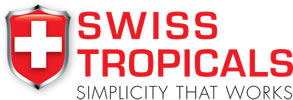Thanks for picking them up, Sarah! Here's what I ended up sending out this morning:
5 Ptychochromis oligocanthus - a relatively peaceful cichlid from Madagascar that grows to about 6-8 inches.
5 Altolamprologus compressiceps Kipili "Zebra" - often sold as "zebra calvus" because they have pearly spots like calvus do.
5 Lepidiolamprologus kendalli Tanzania - an awesome predatory cichlid from Lake Tanganyika with a beautiful pattern as adults. These are already developing the pattern, but will not likely show it much in the bag.
5 Cyathopharynx foae Cape Kachese - a pretty metallic blue featherfin.
(1,1) Aulonocara stuartgranti Chitimba Bay Shallow "Bicolor" - I had to send a pair of these because this group of bicolors is one of the nicest I've had.
5 Copadichromis sp. "Kawanga No-Spot" Undu "Mloto Fluorescent" - a beautiful metallic blue Copad with similar coloration to an azureus, but with a turquoise head and bright white blaze from the snout to the tip of the dorsal fin.
5 Melanochromis baliodigma Masinje - I don't find these to be nearly as aggressive as most Melanochromis, and they have a very unique coloration among mbuna.
5 Mbipia cf. lutea Yala Swamp "Cross-bar" - this is a tough victorian type that does very well with mbuna, and the red and green coloration stands out from the typical blue and yellow of mbuna.
1 Baryancistrus beggini L239 "Blue Panaque" - a pretty, dark blue pleco that does a good job eating algae.
1 Hypancistrus debilittera L129 "Colombian Zebra Pleco" - unfortunately, these also lose a ton of color when they're bagged. Look them up before judging this guy based on the coloration you see in the bag!
1 Panaque cf. nigrolineatus L027a/L330 "Watermelon Pleco" - this is a wood eater. If you don't have wood in the diet, they won't survive long.
1 Brachysynodontis batensoda "Giant Upside Down Syno" - although at this size they don't look that impressive, as they mature, they become a dark chocolate brown to slate gray color. They prefer to swim upside down most of the time, and can grow to over 8 inches.
1 Synodontis flavitaeniatus - a pretty little Syno that grows to about 5-6". They're orange with dark brown horizontal stripes.
1 Synodontis pleurops - sometimes called the hammerhead Syno, these have large bug eyes set very far apart. There's no other Syno quite like them!
3 Microsynodontis sp. "Bumblebee" - these grow no larger than 1.5-2" as adults. They're a dark brown color with thin, vertical yellow stripes.
Have fun at the meeting! Anton is a very entertaining speaker. Make sure you don't miss this one! All that keeps me from being there myself is about 1600 miles.


